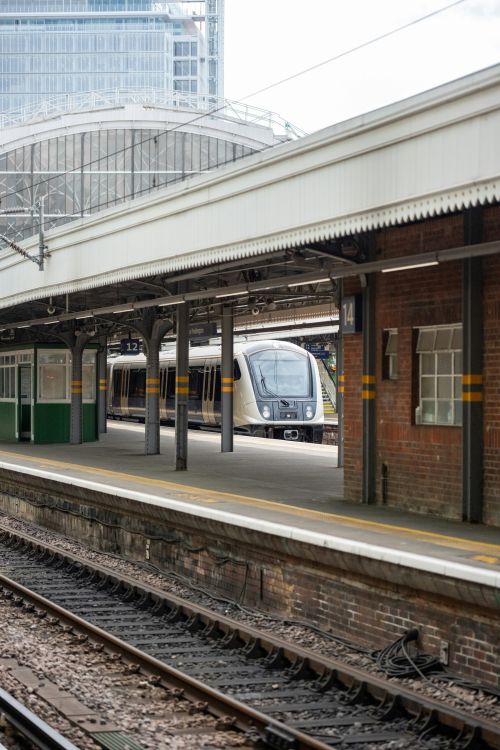The printable version is no longer supported and may have rendering errors. Please update your browser bookmarks and please use the default browser print function instead.
Introduction
Documentation
Syntax
Autoexport from the XML-Schema for element IS:platform of railML ® version 3.2 |
| Documentation
|
railway infrastructure facility located at a station or at a stopping point and designed for safe and convenient passenger service – boarding or leaving passenger train, as well as short-term waiting for a train [Organization for Cooperation of Railways].
|
| Subschema
|
infrastructure
|
| Parents*
|
platforms
|
| Children
|
areaLocation (0..*), designator (0..*), external (0..*), gmlLocations (0..*), isValid (0..*), length (0..*), linearLocation (0..*), name (0..*), networkLocation (0..*), ownsPlatformEdge (0..*), spotLocation (0..*), typeDesignator (0..*), width (0..*)
|
Attributes:
- basedOnTemplate: reference to a template platform (optional;
xs:string; patterns: (urn:uuid:)?[0-9a-fA-F]{8}-[0-9a-fA-F]{4}-[0-9a-fA-F]{4}-[0-9a-fA-F]{4}-[0-9a-fA-F]{12}|{[0-9a-fA-F]{8}-[0-9a-fA-F]{4}-[0-9a-fA-F]{4}-[0-9a-fA-F]{4}-[0-9a-fA-F]{12}}),
- belongsToParent: reference to a parent platform;
use this attribute for grouping of platforms with different parameters
- if some information exists in parent and child, then information in child overwrites it in child
- if some information exists only in parent, then child inherits this information from parent (optional; xs:string; patterns: (urn:uuid:)?[0-9a-fA-F]{8}-[0-9a-fA-F]{4}-[0-9a-fA-F]{4}-[0-9a-fA-F]{4}-[0-9a-fA-F]{12}|{[0-9a-fA-F]{8}-[0-9a-fA-F]{4}-[0-9a-fA-F]{4}-[0-9a-fA-F]{4}-[0-9a-fA-F]{12}}),
- height: DEPRECATED, use element platformEdge instead
the height of the platform edge in metres (optional; xs:decimal),
- id: the identifier of the object; this can be either of type xs:ID or UUID (obligatory;
xs:string; patterns: (urn:uuid:)?[0-9a-fA-F]{8}-[0-9a-fA-F]{4}-[0-9a-fA-F]{4}-[0-9a-fA-F]{4}-[0-9a-fA-F]{12}|{[0-9a-fA-F]{8}-[0-9a-fA-F]{4}-[0-9a-fA-F]{4}-[0-9a-fA-F]{4}-[0-9a-fA-F]{12}}); compare: Dev:Identities
|
*Notice:
Elements may have different parent elements. As a consequence they may be used in different contexts.
Please, consider this as well as a user of this wiki as when developing this documentation further.
Aspects that are only relevant with respect to one of several parents should be explained exclusively in the documentation of the respective parent element.
|
Autoexport from the XML-Schema for element IS:platform of railML ® version 3.1 |
| Documentation
|
This element is not documented in the schema!
|
| Subschema
|
infrastructure
|
| Parents*
|
platforms
|
| Children
|
any (0..*), areaLocation (0..*), designator (0..*), external (0..*), gmlLocations (0..*), isValid (0..*), length (0..*), linearLocation (0..*), name (0..*), networkLocation (0..*), ownsPlatformEdge (0..*), spotLocation (0..*), width (0..*)
|
Attributes:
- belongsToParent: reference to a parent platform (edge);
use this attribute for grouping of platform edges with different parameters (e.g. different heights) (optional; xs:IDREF; patterns: (urn:uuid:)?[0-9a-fA-F]{8}-[0-9a-fA-F]{4}-[0-9a-fA-F]{4}-[0-9a-fA-F]{4}-[0-9a-fA-F]{12}|{[0-9a-fA-F]{8}-[0-9a-fA-F]{4}-[0-9a-fA-F]{4}-[0-9a-fA-F]{4}-[0-9a-fA-F]{12}}),
- basedOnTemplate: reference to a template platform (edge) (optional;
xs:IDREF; patterns: (urn:uuid:)?[0-9a-fA-F]{8}-[0-9a-fA-F]{4}-[0-9a-fA-F]{4}-[0-9a-fA-F]{4}-[0-9a-fA-F]{12}|{[0-9a-fA-F]{8}-[0-9a-fA-F]{4}-[0-9a-fA-F]{4}-[0-9a-fA-F]{4}-[0-9a-fA-F]{12}}),
- height: the height of the platform edge in metres (optional;
xs:decimal),
- id: the identifier of the object; this can be either of type xs:ID or UUID (obligatory;
xs:ID; patterns: (urn:uuid:)?[0-9a-fA-F]{8}-[0-9a-fA-F]{4}-[0-9a-fA-F]{4}-[0-9a-fA-F]{4}-[0-9a-fA-F]{12}|{[0-9a-fA-F]{8}-[0-9a-fA-F]{4}-[0-9a-fA-F]{4}-[0-9a-fA-F]{4}-[0-9a-fA-F]{12}}); compare: Dev:Identities
|
*Notice:
Elements may have different parent elements. As a consequence they may be used in different contexts.
Please, consider this as well as a user of this wiki as when developing this documentation further.
Aspects that are only relevant with respect to one of several parents should be explained exclusively in the documentation of the respective parent element.
|
Changes 3.1→3.2
The element documentation has been changed.
The children have changed.
The attributes have been changed.
Semantics
Best Practice / Examples
#209
The parameter "parentPlatformEdge" is only used for grouping platform edges "in sequence" e.g. platform edges with different heights that
still form one physical PLATFORM EDGE. The grouping of platform edges at one PLATFORM is possible with the <platform> element.
Additional Information
Notes
Open Issues
